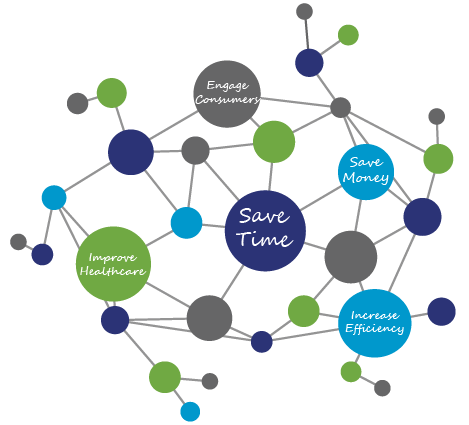Electronic Health Records (EHRs) are an integral part of today’s healthcare system. Despite initial hesitation to switch to an EHR, an overwhelming majority of organizations that have made the change cannot imagine going back to paper. EHRs improve efficiency and increase reimbursements while improving patient care. As providers become more fluent with the technology, EHRs help them with decision making and influence the way a client is treated. Additionally, EHRs enable connectivity, or to use the current buzzword, interoperability.
Interoperability refers to health information technology that enables electronic health information to be easily exchanged. It lets authorized professionals access, exchange and use the health information. In our journey to transform healthcare, Health Information Exchanges (HIEs) have been established. Connecting an EHR to an HIE allows health information to flow seamlessly to the right people at the right place at the right time.
What is an HIE?
But what exactly is an HIE? Historically, when a patient visited a healthcare facility, the provider had two paths to understand the medical history of the patient:
- Check the facility's own EHR system for prior visit information, such as allergies, medications, procedures, etc.
- Ask the patient to fill in any missing information not already documented.
As you know, there are several problems with this process. Not only do patients rarely remember information from prior visits, but they are seen in multiple facilities using various EHR systems, as well. Also, consider a patient who comes into the ER and is unresponsive. How would a provider find out about his or her missing information?
A Health Information Exchange addresses this issue. An HIE is a secure central repository of patient data aggregated across multiple facilities and EHR systems in the same region. The goal is to provide a holistic view of the patient’s electronic health record through a secure, standardized system. EHRs connected to an HIE can share information via the federally defined standards of CCR (Continuity of Care Record) and CCD (Continuity of Care Document). This is the standard all federally-certified EHRs must follow.
Any federally-certified EHR connected to an HIE can (if permitted) send and/or receive information between the EHR and the HIE. Thus, the provider can send and receive electronic information with any community provider also connected to the HIE.
Benefits of Health Information Exchange

Using an HIE streamlines information and connects a practitioner to all aspects of a client’s medical history. Practitioners can receive health information from the HIE, such as a patient discharge summary from a community hospital. This information can be brought into a patient’s chart as electronic health data after it has been reviewed. Using an HIE helps facilitate coordinated patient care, enabling an organization to:
- Save time by minimizing readmissions
- Increase efficiency by moving away from paper and fax machines
- Save money by avoiding duplicate testing
- Provide clinical decision support tools to improve care and treatment
- Minimize medication and medical errors
- Engage consumers about their own personal health information
- Improve healthcare quality and outcomes.
HIEs reduce the amount of time patients spend completing paperwork and briefing their providers on their medical history. This frees up more time for discussions about health concerns and treatments between the patient and provider. By saving time for patients and providers along the continuum of healthcare delivery, HIEs have the potential to both reduce costs and improve health outcomes.
Health Information Exchange Challenges
The push for nationwide interoperability and improved health data exchange have increased HIE and EHR use. In some cases, organizations have been mandated to make the adoption. But, that doesn’t mean HIE connectivity doesn’t come without challenges.
HIE and Data Security
One of the biggest concerns with HIEs is ensuring health data privacy and security are maintained throughout the entire data exchange process. Participating organizations must follow all federal and state requirements related to data security, but they still need to allow information to be exchanged freely for patient care. While information exchange between EHR systems and HIEs is HIPAA compliant, the growing number of cybersecurity attacks have piqued concern about health data security.
A 2017 Black Book survey confirmed these fears extend to patients. Patients surveyed were nervous their digital health information might be shared beyond their physician and hospital. Furthermore, they are not confident their physician will be able to keep their personal information secure. 69% felt their primary care physician “does not demonstrate enough technology prowess” to reassure them that their data is safe.
Physician Burnout
Another major challenge HIE connectivity brings to the forefront is information overload. Physicians are already experiencing burnout. Providers are further burdened with copious amounts of data flooding them, which can lead to less effective care.
While the Patients Over Paperwork initiative is promising to reduce administrative burden and physician burnout, it doesn’t fully account for the volume of data providers will be faced with.
Many providers have lamented that their EHR system is not built with an easy to use clinical workflow. Adding another step to incorporate data from an HIE is just that - another step.
Regardless of the challenges, EHRs and HIEs aren’t going away. They are a major part of the digitization of healthcare and the shift toward value based care. Learning to utilize these tools effectively will help your organization provide more streamlined, effective patient care. And, of course, we recommend working with an EHR vendor who will help you navigate this process with training, support and best practices!
https://www.healthit.gov/faq/what-are-benefits-health-information-exchange
https://ehrintelligence.com/news/what-are-potential-benefits-challenges-of-hie-use
[activecampaign form=1]
Like this blog? Share it!
[ssba-buttons]



